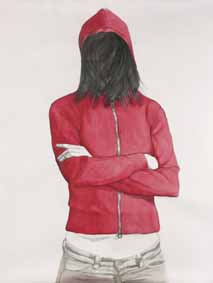
The goal of any biennial exhibition is to act as a kaleidoscope to watch the latest trends, test the state of art and make people reflect. The General Foundation’s Patronat Martínez Guerricabeitia inaugurated last February 14th, at 20:00, the 11th edition of a biennial with 22-year history. With the slogan ‘Nulla aesthetica sine ethica’ (no aesthetics without ethics), the contemporary art exhibition can be visited at Museu de la Ciutat de València until next March 25th.
Biennal Martínez Guerricabeitia’s organization has had the collaboration of the Valencia’s city council, Instituto Valenciano de Cinematografía (IVAC)-La Filmoteca and Universitat de València’s Aula de Cinema. Banco Santander and Fundación Cruzcampo –dependent on Heineken España– finance the exhibition.
Last February 14th, the biennial was presented in a press conference at Museu de la Ciutat. The following important figures were there: Universitat de València’s Vice-principal for culture, equality and planning, Antonio Ariño; activities manager in Patronato Martínez Guerricabeitia, José Pedro Martínez; deputy mayor delegate for culture at Valencia’s city council, Mayrén Beneyto; and the director of Instituto Valenciano de Cinematografía (IVAC)-La Filmoteca, Nuria Cidoncha.
The biennial was created to boost creativity among young Spanish artists and increase the artistic patrimony of Universitat de València at the same time, since at the end of the exhibitions this institution usually buys some of the works exhibited. On this 11th edition, the biennial devotes to the idiosyncrasy inspiring the collection. That is why the 20 works displayed show a social criticism condemning acts of injustice. Aesthetics becomes a tool transmitting motivation for social awareness. Hence the slogan inspiring this edition ‘Nulla aesthetica sine ethica.’
‘Although both our artists and selection board feel always free, the slogan of each edition usually reflects the social problem more present in current events. That is why we have dealt with immigration or environmental probles in past editions. We are nowadays used to lack of ethics on actions which presumably should be irreproachable, so we have decided to transmit this through art and to show how aesthetics displays the lack of ethics’ states José Pedro Martínez, activities manager of Patronato Martínez Guerricabeitia. Despite he insists the economic recession is not the topic chosen for this edition, some artist have decided to portray it, maybe because its origin comes many times from the lack of ethics of the system’s agents.
As usual, the biennial shows twenty works by twenty artists who are introduced by five art critics and five outstanding gallery owners. They have each chosen two works by two Spanish artists. This edition’s selection board is made up of the following galleries: Álvaro Alcácar (Madrid), Alejandro Sales (Barcelona), Sala Pelaires (Mallorca), Rafael Ortiz (Sevilla) and Valle Ortí (Valencia). The scientific board has an enormous experience in the art business. The board is formed of: Ricardo Forriols, Universidad Politécnica de Valencia’s lecturer; Federico Castro Morales, Universidad Carlos III’s lecturer; Víctor Zarza, colaborator in ABC culture section and Universidad Complutense’s lecturer; Rosina Gómez – Baeza, recently director of LABoral (art and industrial creation centre) of Gijón, and of ARCO from 1986 to 2006; and Margarita Aizpuru, art critic and exhibitions organizer.
The selected artists are: Chechu Álava, Jordi Alcaraz, Antonio Ballester, Patricio Cabrera, Colectivo LimpiArte, Luis Cruz Hernández, Carlos García-Alix, Chus García-Fraile, Iñaki Gracenea, Mari Puri Herrero, Cristina Lucas, Xisco Mensua, Cori Mercadé, Eugenio Merino, Nico Munuera, Amalia Ortega, Paco Rossique, Guillermo Rubí, Mery Sales and Matías Sánchez.
After ten editions celebrated since 1990, Patronato Martínez Guerricabeitia has added to the collection 21 works of current important artists at a national level. Thanks to the biennial, today the Universitat de València can have works by artists like Carmen Calvo, Curro González, Javier Baldeón and Rogelio López Cuenca, among others.
As happened in the last edition, thanks to the collaboration of IVAC-La Filmoteca and the Universitat de València’s Aula de Cinema, a cinema cycle will be shown to help the biennial’s contextualization titled ‘Imágenes de la crisis’.
This cycle, to be shown from February to April, is divided in two parts: La Gran Depresión, by Univeristat de València’s Aula de Cinema, and El crack financiero actual, scheduled by La Filmoteca for the Luis G. Berlanga hall. Every Wednesday of this month, Aula de Cinema is showing at Col•legi Major Lluís Vives residence hall a films cycle. These films portray either through their plot or through their production contexts the USA’s Great Depression in the 30’s.
In its turn, La Filmoteca’s Luis G. Berlanga hall is hosting next March the showing of a selection of films –both documentary and fiction ones, which will tackle with the causes and consequences of the current economic chaos. Contemporary cinema industry, from the independent to the Hollywood industries, do not remain indifferent to this situation.
Last update: 16 de february de 2012 08:51.
News release



















